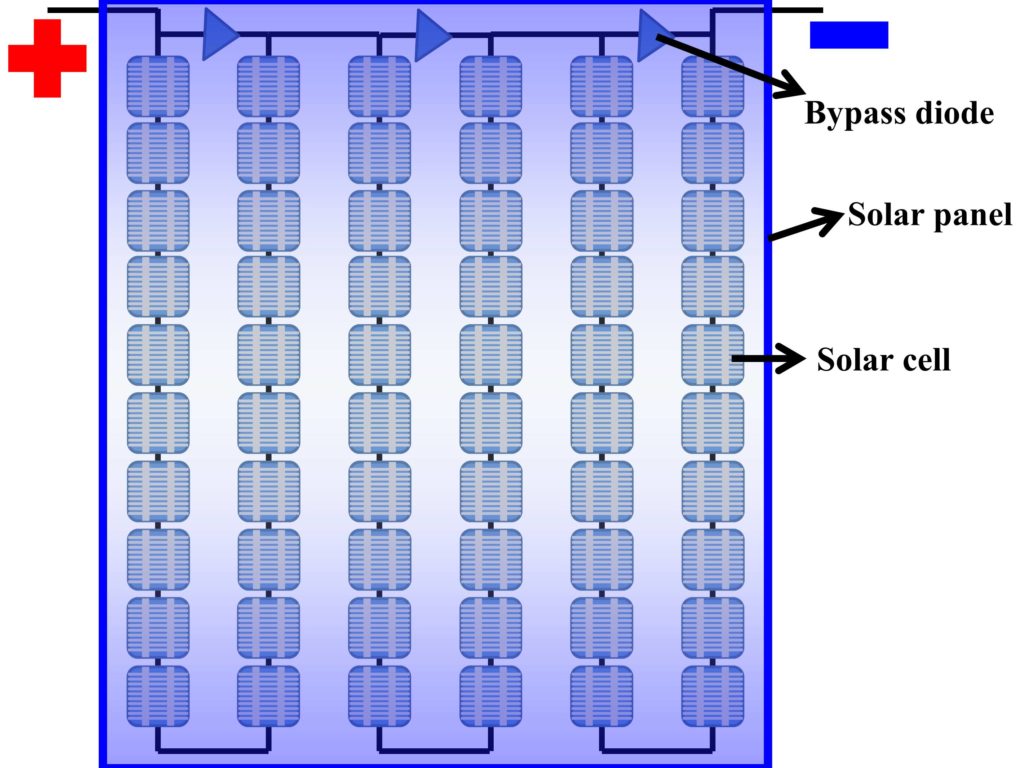From solar cells to solar panels
Solar panels (photovoltaic panels-PV) are a combination of multiple solar cells. Solar cells generate voltage and current and typically these values are too small for the solar cell to be employed for power generation alone. Therefore, in order to increase these values, a number of solar cells are connected together to form a solar panel, which are in turn connected to make a PV system. Now this connection can be either in series, parallel, or both. In the series connection of solar cells, the voltages add up whereas, in parallel connection, the current from individual cells adds up.
Solar cells and their connection
A typical solar cell used in commercial solar panels generates an approximate voltage of ~0.5-0.6 Volts and a current of approximately ~30-35 milliamperes per square cm which comes out to be 6.5-8.5 Amperes for a whole cell. Usually, 60-72 of such cells are connected together in series to forms a solar panel. A visual representation of connected solar cells can be observed in Fig. 1. The figure shows that all the cells are connected in series, which will make the voltage of the whole panel to be around ~30 Volts. The reason for not connecting the solar cells in series is to reduce the line losses. The losses are directly proportional to I2R, where, I represents the current and R represents the resistance. Therefore, the losses increase by the square of the current.

The Fig. 1 also shows bypass diodes. Bypass diodes are also one of the key components employed in solar panels for their protection. Usually, in a solar panel of 60 cells, three bypass diodes are provided for strings of 20 cells each. Bypass diodes help to disconnect a string when a mismatch in output current occurs. This mismatch in output current can damage the affected cell and in turn, damage the solar panel.
Solar panels to form PV system
The output of a single solar panel is not enough for large power generation, therefore, a large number of PV panels are required to meet the power requirements of a specified area. A PV system is formed from a large number of solar panels connected in series, parallel, or both to generate the required amount of power. The same rules of solar cells apply while connecting the solar panels, and therefore, they are also connected in series to avoid line losses. A collection of solar panels connected in series is called a string. Multiple strings are employed in a typical solar power system. A depiction of solar panels into strings is shown in Fig. 2, where each string shows a different connection of solar panels.

In order to analyze Fig. 2, let’s consider the output voltage of a single solar panel to be 32 V and 8.1 A. The resistance of the conductor is taken to be 0.1 Ω (ohms), just for the comparison of line losses. The three cases presented in Fig. 2 can be addressed as follows.
1. Series connection of PV panels
String 1 in Fig. 2 shows the series connection of 8 solar panels. Since the voltages add up in series connection, string 1 will yield 256 V, whereas its current will remain constant at 8.1 A. The line losses represented by I2R will be 6.561 W (watts).
2. Parallel CONNECTION OF PV PANELS
String 2 in Fig. 2 shows the parallel connection of 8 solar panels. Since the currents add up in parallel connection, string 2 will yield 64.8 A, whereas its voltage will remain constant at 32 V. The line losses will be 419.904 W.
3. Hybrid series and PARALLEL CONNECTION OF PV PANELS
String 3 in Fig. 2 has series and parallel connections, where 4 solar panels are connected in series and 2 such groups of 4 solar panels are connected in parallel. String 3 will yield 128 V and 16.2 A. The line losses will be 26.244 W.

Thanks for giving such a useful information
Glad to be of service. You can also leave suggestions with us if there is a particular topic you would love to read.